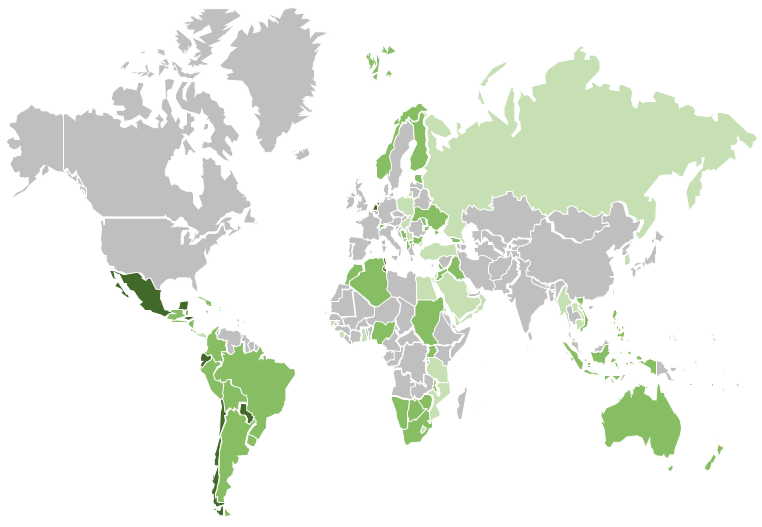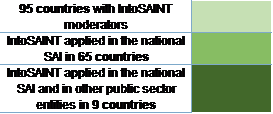
Integrity
Case
IntoSAINT: proven value in safeguarding integrity in SAIs and Public Sector Organisations
June 22, 2020
Tags: ISSAI 12, IntoSAINT, SAI, integrity controls, self assessment
The current reality that we are confronted with is testing the way that public services are delivered. Now more than ever, citizens are expecting swift and real action from their governments, while maintaining effective performance and service delivery. Supreme Audit Institutions (SAIs) play a crucial role here, not just by auditing government finances and performance, but also by setting an example for strengthening public integrity.
Highlights
- Self-assessment tools such as IntoSAINT are an effective way to strengthen public sector integrity.
- The position that SAIs occupy means that they are able to help public sector organisations assess their integrity risks and improve their integrity management.
- The real impact of these tools lies in bringing people together around a shared vision of integrity and the actual implementation of this vision.
Integrity policymaking should be a core process in all public sector organisations, but it can be difficult to know where to start and to continuously adapt policies under complex and evolving circumstances. SAIs can address these challenges by using the IntoSAINT tool themselves, and by introducing it to public sector organisations.
What is IntoSAINT?
IntoSAINT (INTOSAI Self-Assessment of INTegrity) is a self-assessment tool that allows both SAIs and public sector organisations to assess integrity risks and the effectiveness of their integrity mechanisms. It is a great way to initiate the bottom-up design of integrity policies in line with the needs of the organisation. This assessment consists of a workshop that usually lasts three days, with a cross section of the institution’s employees, and is conducted by at least two external moderators. The workshop concludes with a report, which includes tailor-made recommendations to improve integrity management within the organisation.
Since 2010, the International Organization of Supreme Audit Institutions (INTOSAI), recognising that SAIs should strive to be model organisations, has supported the development of IntoSAINT. INTOSAI has facilitated moderator trainings and stimulated the application of workshops to help SAIs across five continents make the most of the tool. So far, SAIs in over 65 countries have used the tool. The following map shows where the tool is being used in the world as of June 2020.

The global roll-out of the IntoSAINT tool (June 2020)

Impact of IntoSAINT
When it comes to IntoSAINT, the number of workshops is not the only measure of success. Indeed, one must look closer at the transformation that often follows it. The positive impact of the tool has been two-fold: the first is the immediate awareness that the workshop participants acquire on the relevance of integrity in their daily working lives. The self-assessment is an eye-opener for them. They recognise that no one is truly incorruptible. Instead, they understand that as well as being public servants, they are human beings that can be fallible, and as such it is crucial for them to be better prepared in confronting and reacting to potential integrity dilemmas.
The second key result is that the tool facilitates senior management in establishing integrity policies within public sector organisations. They should create a suitable environment within the organisation that encourages ethical behaviour and prevents potential integrity breaches, in turn affecting the organisation’s internal control processes. IntoSAINT is not only a tool for SAIs to use and promote. Internal auditors can also consider using the tool, or elements of it, when assessing an organisation’s integrity measures.
In short, IntoSAINT helps management and employees develop a shared vision of integrity in their organisation.
SAIs leading by example
The Mexican SAI has applied the self-assessment tool on three occasions, in 2012, 2013 and 2019. These assessments set in motion the creation and subsequent consolidation of the current integrity policy, which includes a code of ethics, code of conduct and guidelines for preventing conflicts of interest. This integrity policy is overseen by an integrity committee, which is an internal structure that deals with complaints from personnel regarding integrity issues. The committee has also developed awareness-raising campaigns and specific training programmes. Furthermore, the tool has been promoted by the Mexican SAI among public sector organisations. As of June 2020, over 150 public officials from different government institutions have been trained as IntoSAINT moderators, and the self-assessment has been undertaken in 30 local SAIs and in 10 sub-national transparency bodies. In this regard, the Mexican SAI has been leading the way in developing a shared vision of public sector integrity in the country.
Elsewhere, the SAI of Chile adopted an Ethics Management Plan after the implementation of the tool in 2017. The tool has also been applied in 23 public sector organisations, and the credibility of the Chilean SAI enabled the initiation of a Public Integrity Pact in February 2019, signed by senior management of all public institutions in the country.
The introduction of such innovative mechanisms, as well as many others not mentioned here, was only possible after the application of IntoSAINT. IntoSAINT brings people together and allows them to build a shared awareness of integrity in public sector institutions. The real success of the tool lies in using this awareness for the implementation of the recommendations to strengthen the institution’s integrity. Real and lasting change is possible when this is transformed into actual policies that, at an aggregated level, contribute to good governance, and ultimately, to the lives of citizens.
| About the expert Mr. Francisco Parral is Chief of Department at the National Anticorruption System Directorate at ASF (SAI of Mexico) . Mr Parral is also responsible for the global roll-out of the IntoSAINT tool through the INTOSAI Capacity Building Committee |
The views in this article are the author’s only, and do not necessarily represent the views of the OECD or its member countries.
Let’s Discuss
Integrity
- You must be logged in to reply to this topic.

